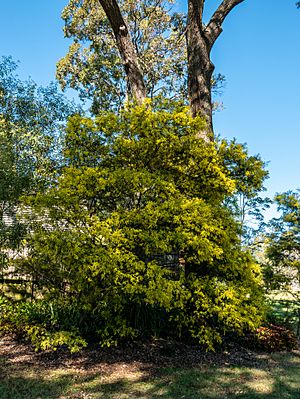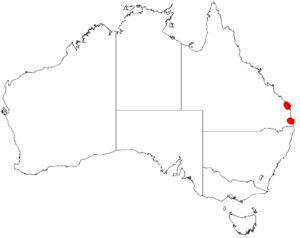Eprapah wattle facts for kids
Quick facts for kids Eprapah wattle |
|
|---|---|
 |
|
| Scientific classification | |
| Genus: |
Acacia
|
| Species: |
perangusta
|
 |
|
| Occurrence data from AVH | |
The Acacia perangusta, often called the eprapah wattle, is a type of tree or shrub. It belongs to the Acacia family. This plant is native to eastern Australia.
What Does it Look Like?
This shrub or small tree can grow quite tall. It usually reaches about 7 meters (23 feet) high. It can also spread out to about 5 meters (16 feet) wide, making it look bushy.
Its branches are reddish-brown and smooth. They are also a bit angled at their ends. Like most Acacia plants, it has special leaf-like structures called phyllodes. These are not true leaves.
The phyllodes are thin, smooth, and stay green all year. They are long and narrow, usually 4 to 8 centimeters (1.6 to 3.1 inches) long. They are very thin, only about 1 to 1.6 millimeters (0.04 to 0.06 inches) wide. Sometimes, they have a blunt tip with a small point. Each phyllode has a clear main vein and a few faint side veins.
When the eprapah wattle blooms, it produces clusters of flowers. These flower clusters grow along a stem that is 2.5 to 4 centimeters (1 to 1.6 inches) long. The flowers are small and round, like little balls. Each flower cluster has 9 to 12 lime-yellow flowers.
After the flowers bloom, smooth seed pods start to form. These pods have a white, powdery coating. They are slightly pinched between each seed and are rounded on the outside. The pods can be up to 7.5 centimeters (3 inches) long and about 5 millimeters (0.2 inches) wide. Inside, the seeds are lined up lengthwise.
Where Does it Live?
The eprapah wattle is found only in Queensland, Australia. This means it is endemic to that area. You can find it from the Burrum Range in the north. It also grows about 30 kilometers (19 miles) southeast of Brisbane.
This plant usually grows along small streams and creeks. It prefers to grow in sandy or clay loam soils.

